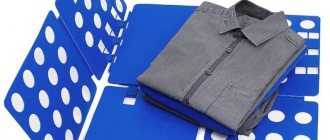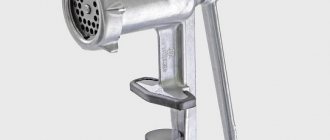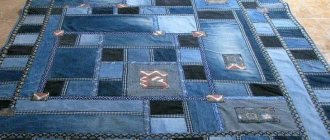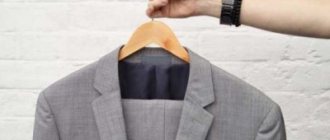Hi all! Today I want to share with you my next master class on sewing a T-shirt or T-shirt as you like.
I also recommend watching how to sew a blouse with a peplum -
Probably no wardrobe is complete without T-shirts; almost everyone wears them, both boys and girls, adults and very little children. In general, this is a thing for all times, and every wardrobe should have one!
I will show you the simplest sewing method so that absolutely anyone can do it. Moreover, for sewing it is not necessary to have an overlocker and a cover-stitching machine; it is quite possible to get by with an ordinary household sewing machine.
I will sew a T-shirt for both myself and my daughter, that is, using the same principle, you can assemble both an adult and a children’s T-shirt. For sewing material, I recommend using a jersey with lycra or any other suitable knitwear, for example, rib or footer, in general, whatever you like best or what is available.
Well, I won’t bore you with more just letters, let’s get down to business!
Selection of materials and tools
Elastic fabrics are used to sew T-shirts and T-shirts. The material for the product should be comfortable, practical, pleasant to the touch. T-shirts with a loose fit or tight fit are best made from knitwear. This fabric may differ in composition, but the properties remain the same. Knitted fabric has the following qualities:
- softness;
- hygiene;
- ease of care;
- hygroscopicity;
- wearing comfort.
Knitted fabric is suitable for sewing T-shirts.
It is knitwear that is most often used by novice tailors for sewing T-shirts. It is convenient to cut and easy to process on a sewing machine. Before sewing a knitted T-shirt with your own hands, you should prepare the following tools:
- chalk or a piece of soap;
- ruler, measuring tape;
- eye pins;
- threads for sewing machine and hand basting;
- scissors;
- sewing machine;
- a simple pencil for transferring the pattern;
- sewing machine needles.
Since elastic knitwear is used in the work, a certain type of machine needle is selected. To do this, it is better to use a tool marked stretch. These needles are suitable for synthetic knitwear and fabrics with a high lycra content. If you use cotton or woolen knitwear for work, you must purchase a needle marked jersey.
Fabric selection
For women's T-shirts, light, body-friendly fabrics, such as knitwear, are usually chosen. A bioelastic, stretchy material containing cotton or viscose is best suited. But you can use other fabrics:
Sewing a T-shirt
- interlock;
- footer;
- Capiton.
For example, the pattern of a women's T-shirt in tailoring uses thin, airy fabrics. Of course, there are exceptions because the material is selected according to personal preference.
Fabrics
The nuances of preparing knitwear for sewing
Before cutting the knitted fabric, it is prepared. Depending on the type of material - interlock, jersey, footer, terry jersey or elastic, the shrinkage of the fabric is taken into account. Before cutting, the cotton fabric is washed and ironed. Natural fabric can only be washed by hand, but if it contains synthetic fibers, you can safely put the fabric in the washing machine. To ensure that the T-shirt pattern fits the fabric base well, after washing the knitwear is ironed with an iron at medium power; it is allowed to use the steaming function.
A few more nuances of preparing for sewing:
- Before sewing, it is important to adjust the stitching: select the length of the stitches;
- the thread tension should not be too strong, it is better to choose medium parameters;
- competent sewing with your own hands requires selecting the thickness of the needle - it is determined based on the thickness of the fabric.
For beginning craftsmen who use thin knitted fabric, you should choose a needle marked H-HS, size 1-3. For medium density fabric – marked H-SUK, size 3-5. It is better to sew thick knitwear with a tool marked JH-SUK, size 7-10 and a wide eye.
Before cutting, knitted fabric must be washed and ironed.
Preparing the elastic for the collar
The length of the elastic for processing the neck of a T-shirt is calculated from the circumference of the neck, from which you need to subtract 10 cm.
The neckline is usually finished with ribbed knitted elastic. Its width should be twice the intended edging. It is important that the ribs of the elastic run strictly perpendicular to its length.
The finished piece of elastic needs to be folded in half, face outwards, and ironed, then you need to stitch the edges using a sewing machine, closing them into a circle.
How to take measurements
To make a T-shirt pattern, you need to take the measurements correctly. The person being measured should stand straight and not tense. The figure is allowed to wear thin clothing that does not add excessive volume. The measurements for women and men are the same:
- Neck circumference - a measuring tape is laid over the seventh cervical vertebra and wrapped around the neck in the area of the jugular cavity.
- Chest circumference - the tape runs horizontally around the torso through the protruding points of the chest.
- Waist circumference - the measuring tape is applied around the torso along the waist line.
- Hip circumference - the measuring element must be placed along the protruding buttock points; the indicators are necessary in order to construct a pattern for a long T-shirt.
- Shoulder width - the distance from the beginning of the shoulder to the line of the sleeve is measured.
- Shoulder circumference - measurements are taken with the arm hanging freely.
- Wrist circumference - the tape is passed around the wrist.
- Sleeve length - selected at the request of the person being measured, the distance from the end of the shoulder seam is measured.
- Back length - measurements are taken from the base of the neck.
Before taking readings, the waist line is tied with a thin braid horizontally; in sewing, this is called a “setting belt.”
Making a pattern
If the pattern is created correctly, the finished T-shirt will look like a high-quality factory product. This way you can sew women's or children's clothing by creating a pattern yourself.
Lay the T-shirt face up on the table. This is one of the simplest knitted products, which usually consists of two equal halves. Inspect the product to determine the features of its cut and create a T-shirt pattern:
- Classic T-shirts have side and shoulder seams on the folds. This indicates that the front and back halves of the product are equal.
- Some T-shirts have side seams that extend to the back. In this case, the front half does not match the back half.
If all the seams are on the folds, then you can start making the pattern. To do this you need to do the following:
- We spread tracing paper on the table and fold the product in half, matching the shoulder and side seams. Also make sure that the armhole lines are exactly on top of each other.
- Take a pencil and carefully trace the product on all sides (first the middle, then the bottom of the product and the side cut). Next, we bend the sleeve so that the armhole seam is visible, but the product does not come off the table. We outline the armhole without moving the main part of the product.
Lastly, we mark the shoulder section and neckline. To do this, bend the knitted tape, tracing the neckline. - Fold the tracing paper in half along the middle of the back and cut it out. The result should be a pattern for half a T-shirt.
- Now you need to cut along the fold. We put one half aside for now, and turn the second into a part of the shelf. To do this, take the product and place it face up. We measure the distance between the middle part of the neck seam along the back and front. For example, it is 10 cm. We mark it on tracing paper and connect it to the highest shoulder point through a smooth bend.
- As a rule, the armhole of the front half is deeper than the back half. Therefore, we fold the product in half again and apply it to our pattern. Transfer the deepest line of the armhole to tracing paper. Next, cut off all excess from the armhole and neckline.
- Create a sleeve pattern. We apply the front half of the T-shirt sleeve to the tracing paper, folding it along the elbow section. We outline the bottom line and side cuts.
After this, securely fix the sleeve with your palm and carefully bend the product. We draw a line exactly along the cut.
This was the front half of the sleeve.
To get the back half, the T-shirt is turned over (you need to align the fold of the sleeve with the edge of the pattern). We outline the sleeve in accordance with the recommendations described above. - Cut out the sleeve pattern. You should not cut it into front and back halves. Simply fold the resulting pattern along the center line.
Experienced seamstresses can adjust patterns at their discretion.
We have prepared for you a detailed video course “Sewing Basics”
Go to course page
Pattern construction and cutting
In order for the pattern of a T-shirt or T-shirt to accurately convey the measurements obtained, a number of rules for the basic construction of the drawing are followed. For work, graph paper is used - it initially has markings, so it will be easier to draw. All measurements obtained, except length, are divided in half. The pattern is drawn in half size. Principles for constructing the model:
- draw a right angle, mark the length of the product down from it;
- set aside half the chest circumference to the right;
- Draw the height of the chest down with a straight line - this will be the depth of the armhole;
- measure half the width of the back on it;
- calculate the armhole: divide the chest circumference by two and add 3-4 cm;
- draw perpendiculars from the obtained points;
- Divide the armhole area in half and draw a line down;
- set aside 18-20 cm from the waist, noting the hip area;
- draw a neck line: divide the neck circumference by 3 and add 0.5 cm;
- to build a sleeve: draw the length of the sleeve down, and put its width to the right.
The pattern of a women's T-shirt differs from a children's or men's model in that it has a more fitted silhouette. When cutting a product for men, the waist area is made freer, and when drawing a pattern for a child, it is necessary to take measurements with a margin. If it was decided to build a pattern based on a cut old T-shirt, take into account the seam allowances that are already on the product.
Sewing a sports T-shirt
A sports T-shirt is sewn as easily as possible:
- Fold the back and front pieces inside out;
- Sew these parts together;
- Fold and stitch the edge of the sleeves;
- Align the back and front pieces and sew the sleeves in a circle;
- Fold the front and back and sew the side seams;
- Sew the elastic “tube” inside out in a circle;
- Finish the bottom edge of the T-shirt with an overlock or zigzag stitch;
- Fold the bottom edge of the T-shirt and stitch it.
Sewing stages taking into account the model
It’s easy to sew a T-shirt with your own hands. Step-by-step instructions will help novice needlewomen make a product for a man, woman or child. Before sewing, you should prepare the necessary materials and tools.
Women's with dropped sleeves
The off shoulder T-shirt pattern is made based on the basic model with some modifications. To do this, it is necessary to increase the length of the shoulder seam: place the cut out parts of the front and back on tracing paper, connect the shoulder seam with a smooth line to the armhole. Then we perform step-by-step actions:
- We sew the shoulder seams: fold the back and front parts of the product and sew them on a machine, retreating 1.5 cm from the edge.
- We process the neck of the T-shirt; the easiest way to do this is with tape from the same fabric. Calculation of the formula for the length of the binding - multiply the width of the neck by 0.8.
- Iron the binding along the neckline.
- We machine sew the side seams.
- Iron the side seams.
- We bend the sleeves and grind them on a machine.
- We fold the bottom of the T-shirt and sew it on a machine with an even stitch.
Don’t forget to pre-process all edges using an overlocker; if this is not the case, then use a special overlock stitch on a machine. We try on a women's T-shirt, check if it matches what we want and, if necessary, correct any shortcomings.
Stylish men's for beginners
Before you cut out and sew a men's T-shirt, you should decide on the fabric. You can use a cooler; it makes convenient and practical products. Next we follow the step-by-step algorithm:
- We cut out the pattern pieces, adding 1 cm to the seams on each side.
- At the bottom of the sleeves we will add 6 cm.
- Sew the front and back at the shoulder seams.
- We straighten the front and back and sew the sleeves into the armholes. Although the patterns are simple, we fasten the parts with pins before sewing.
- Fold the front and back along the shoulder seams, sew down the side seams and the bottom of the sleeves.
- To trim the neckline we use knitted fabric like ribana.
- To close the seam on the neckline, sew another strip of ribana.
- We process the bottom edge of the T-shirt using an overlocker.
- We bend the edge of the bottom cut and hem it. It is advisable to use a double knitting needle when hemming the edge.
Using the same algorithm, you can sew a men's T-shirt with one-piece sleeves.
Children's T-shirt
T-shirts are often made without sleeves. Children feel free and comfortable in them. If you decide to sew a product with short sleeves, then you need to take shoulder measurements. Before work, we set the knitted stitch on the machine, it looks like a zigzag. Its optimal length is 1.6 cm, width is 1 cm. Let’s start assembling the model:
- We secure the shoulder seams with pins.
- We grind the parts on a machine.
- We process the neck with binding.
- We edge the armholes with binding.
- Sew the side seams.
- We bend the edge by 2 cm and sew it on a machine.
You can make the binding yourself. For this purpose, knitted material is used that matches the color of the main fabric. A long strip 5 cm wide is cut out of it and attached to the neck of the T-shirt.
How to sew it yourself
An original T-shirt or T-shirt, sewn yourself, will look very impressive and differ from all other models that are produced in batches at factories. Creating such a designer wardrobe item does not seem to be a difficult task if you consistently follow several important points. And most importantly, it will take much less money to sew than to buy a ready-made trendy T-shirt. When asked how to sew a T-shirt with your own hands for beginners, the following points will help.
Sewing
When the pattern is ready, you need to process the seams on the shoulders, connecting the front and back of the product. To do this, you also need to use an overlocker to finish the edges of the product. This creates a base that will only need to be connected along the side lines. If this is a T-shirt pattern, then the shoulder seams also need to be sewn, they will just be shorter. Overlock in this case is used to ensure that the wrong side of the product looks neat, without any pieces of fabric or thread sticking out from under the seams. Sewing a T-shirt with your own hands is quite simple, it is easier than sewing a T-shirt, because it does not have sleeves. It takes less fabric and there is no extra effort to cut out the sleeves to sew them in.
You might be interested in this: How to sew a beautiful bow from fabrics yourself
Neck facing
Usually, when sewing a neckline, the front and back of the product are divided in half, marked with a pin or colored thread for better visibility. The shelf and backrest need to be folded in half again and additional points placed. For the neckline, it is necessary to make allowances and edging of the neckline. It is important not to forget to leave a few centimeters from the back for allowances. This strip should be smaller than the neck itself. Otherwise, it will turn out unsightly and spoil the full appearance of the product.
Neck facing
Armhole processing
The armhole, that is, the end of the sleeve, is also processed so that the threads do not stick out, and the sleeve is neat and looks neat. It is usually finished with bias tape. The side seams are joined and a hem is made. But sometimes, in order to save processing time, as well as save materials, only an overlocker is used. This looks unusual, since everyone is accustomed to the usual processing of armholes.
Processing side seams
They are swept away and the edges are joined. It is important not to forget about the side seams, since they must also be processed for the proper appearance of any product, not just a T-shirt or tank top.
Processing side seams
Bottom hem
The bottom of the product is folded by sewing elastic along the bottom edge of the T-shirt. This is done so that the T-shirt does not ride up during active movements or raising your arms. Or you can simply fold the edge of the T-shirt and stitch it, folding it in half. This way the T-shirt will have a looser edge and will not bunch up at the end with an elastic band.
Bottom hem
Thus, sewing a simple T-shirt is easier than it might seem at first glance. What is important is a clear sequence of actions in drawing up a sketch of the product, creating a pattern and sewing the product itself. You need to decide in advance on the design, material and composition of the fabric that will be used for sewing, and the decorative details needed in the process. And then start sewing the planned T-shirt or tank top.
Decor options
Regardless of what cut the T-shirt is, you can decorate it to your liking. Original jewelry will make the item unique and stylish. The most commonly used methods are:
- Women's products are decorated with flowers made from ribbons, imitate cuts, put on felt decorations, and use beads and rhinestones.
- Men's T-shirts with full sleeves or tank tops are decorated with rivets, thermal printing with inscriptions, and stylish pockets are sewn on.
- Children's T-shirts are equipped with appliqués, ribbons, embroidery, beads, and luminous figures.
Decorative elements for children under three years of age must be securely fastened. It is better not to use beads, stones and other voluminous decorations. A child can tear them off and swallow them. The best way to decorate is embroidery or fabric appliqué.
Sewing a T-shirt with your own hands is not difficult. To do this, it is enough to follow the recommendations presented, as well as correctly prepare the knitted material and needles for the sewing machine. You can decorate the product at your own discretion, using bright or strict elements.
Sewing a children's T-shirt
A children's T-shirt is sewn even simpler than previous models. Due to the lack of sleeves, the process is accelerated; to sew a cut-out children's T-shirt, you need:
- Fold the back and front pieces inside out;
- Sew shoulder seams;
- Cover the neckline with an elastic band or bias tape;
- Frame the armholes with an elastic band;
- Sew side seams;
- Fold and stitch the bottom edge of the T-shirt.
What will be useful at work
Before you sew a children's T-shirt or clothes for an adult, you need to choose the right fabric. In both the first and second cases, it is recommended to use knitwear. Similar fabrics may have different compositions, but they always have identical properties. Among the main qualities of this material are the following:
- soft;
- does not cause difficulties in care;
- comfortable to wear.
It is not surprising that most often they decide to make T-shirts from knitwear. This material is easy to process and cut. True, before starting the main work you need to prepare everything that may be useful:
- soap or chalk;
- centimeter;
- pins;
- scissors;
- paper and pencil;
- threads and needles;
- sewing machine.
When everything is prepared, you can safely create a T-shirt with your own hands.
How to “tie” overlock stitch threads
You cannot cut the overlock stitch threads, otherwise the seam will unravel. Leave long tails of the overlock stitch and insert them directly into the seam using a large eye needle.
It is very convenient to use this device, designed for lifting loops of knitted fabric.
In this video you will learn the sequence of sewing women's or children's shorts from knitted fabric.
Which fabric is better to choose for sewing a T-shirt?
Body comfort, as well as the reliability and durability of a T-shirt, directly depend on the material from which the product is made.
Therefore, it is very important to pay the necessary attention to the choice of material so as not to regret it in the future.
Most often, when sewing T-shirts, simple cotton, blended and synthetic materials are used.
When choosing, it is necessary to take into account the density of the fabric, the quality of the print (if necessary), composition, susceptibility to shrinkage and creasing.
Since a T-shirt is everyday wear, it is often subject to mechanical stress and wrinkles easily. Ironing such products is not always convenient.
If you plan to directly print on a T-shirt, it is better to select a mixed material with a predominance of cotton and a small addition of elastane fibers. On synthetics you can use the capabilities of sublimation printing.
Among the most popular materials for sewing T-shirts is cotton. This is a soft material that allows air to pass through well, absorbs moisture and wrinkles very little during use. However, the fabric is not able to protect against the cold and shrinks significantly after washing. Best suited for casual T-shirts and polos.
An alternative to cotton is polyester. It retains its color for a long time, is resistant to various types of stains, practically does not wrinkle and retains its original shape throughout its operation. The downside is poor breathability and electrification. Sportswear is most often made from polyester.
Viscose provides excellent breathability, allowing the body to breathe. This is a light and soft material that practically does not stretch. However, slight warping in washing, shrinkage and sensitivity to sunlight make it less popular than the options discussed above.
Linen is characterized by good thermal conductivity, increased strength and durability. However, T-shirts are not often made from it, since the material wrinkles greatly during use, is difficult to iron, gives serious shrinkage and quickly loses its shape during wear. Linen products are definitely not suitable for everyday wear.
The most popular options today are cotton-blend fabrics that combine the advantages of several materials at once. In this case, cotton, lycra, elastane, polyester and viscose can be mixed.
Calculation of the required amount of material
To calculate fabric consumption, you need to know exactly the length and width of the future T-shirt. For products with sizes 42-52, you will need a cut length of about 70-80 cm with a fabric width of more than 150 cm.
If the roll is less than 150 cm wide, you need to leave about 30 cm at the bottom for individual sleeve parts. The same applies to cutting T-shirts in large sizes from 54.
Expert opinion
Maria Anishchenko
Experienced seamstress, total experience 18 years
Immediately before cutting, the fabric must be soaked in water at a temperature of 40°C for about 15 minutes or ironed with a hot iron with a steam function.
This way you can avoid unpleasant shrinkage of the product after sewing. If it is clear in advance that the fabric will shrink, add about 10 cm to all sizes.
It is necessary to iron the material as carefully as possible so that folds do not appear on the fabric. In the future, it will be very difficult to get rid of such folds.
Processing the armhole of a T-shirt
Processing the armhole with edging is done in the same way as the neckline, only it is even simpler, since there is no need to make markings and stretch the strip. Simply overlock the folded strip along the armhole.
It is convenient to iron the edging of the neck of a T-shirt on a special block for ironing sleeves.
Iron the armhole edging on an ironing board.
Now all that remains is to join the side seams of the T-shirt and make a hem.











